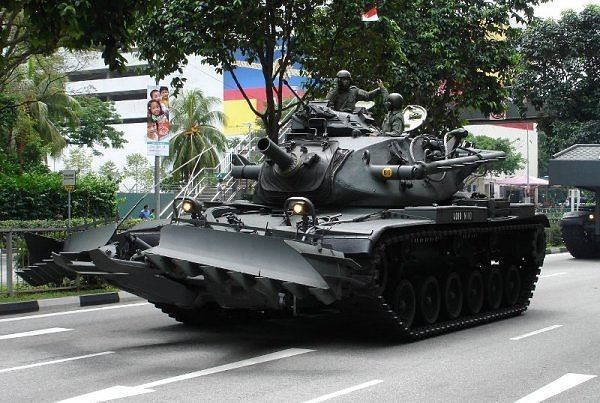Place of origin United States Used by See operators | In service 1965–present Designed 1963 | |
 | ||
Wars Vietnam WarGulf WarBosnian War | ||
The M728 Combat Engineer Vehicle (CEV) is a military engineering vehicle based on an M60A1 Patton main battle tank chassis with a hydraulically operated dozer blade mounted on the front, thus effectively functioning as an armored bulldozer, plus an A-frame crane boom hinged on either side of the turret and a winch.
Contents
Design
Based on the chassis of the M60 Patton tank, the armament was changed from using the 105mm M68 rifled tank gun used on the standard M60/A1/A3, to a 165mm M135 short-barrelled demolition gun with 30 rounds of HEP (high explosive, plastic) ammunition. The M135 is a license-built copy of the 165 mm L9A1 gun that was used on the British Army's FV4003 Centurion Mk.5 AVRE (armoured vehicle Royal Engineers) tank. Depending on the usage, the gun can be depressed and elevated against targets up to an effective range of 925 metres (1,012 yd). The gun's primary purpose is for clearing defensive fixtures and obstacles, such as walls, fences, roadblocks and bunkers, or for destroying buildings and is generally not meant to be for use in anti-personnel or anti-tank warfare.
The main gun has a coaxial 7.62×51mm NATO M240 machine gun, with 2,000 rounds of 7.62mm ammunition. In addition, a .50 caliber M85 machine gun is mounted in the commander's cupola; this has 600 rounds of ammunition.
As an alternative to the mounted dozerblade, the vehicle can be equipped with a mine clearing rake for clearing land mines. In total, 291 M728 CEVs were produced.
Deployment
It was first deployed in 1965 during the Vietnam War. It was also used in the Operation Desert Shield and Operation Desert Storm phases of the 1991 Gulf War.
During Operation Desert Storm, the M728 CEV was unable to keep up with the M1A1 Abrams in the armored formations and spearheads, due to the limits of the M60 chassis and power train. Many maneuver units simply left the M728 CEV behind rather than let it slow their advance. Such was also the case with the mine rake-equipped M728 CEVs. As originally anticipated, the commanders in the field planned for their use as a part of the sand berm breaching operation, but decided to leave them behind once they began the pursuit and exploitation phase of the operation. In the post-war assessment, many armored unit commanders were in agreement that the engineers needed an M1 Abrams based chassis for heavy breaching and gap crossing equipment to keep pace with the Abrams. As a result of this, the M728 was no longer used by active duty units from 2000 onward, although it still is in use by the Army National Guard and US Army Reserve. Current users include Saudi Arabia and Singapore.
Some M728s were acquired for use by the United States Department of Justice's FBI and ATF SWAT teams to conduct potentially dangerous operations. In particular, it has become associated with the 1993 Siege of Waco, Texas, due to it being caught in dramatic fashion on video during the siege.
